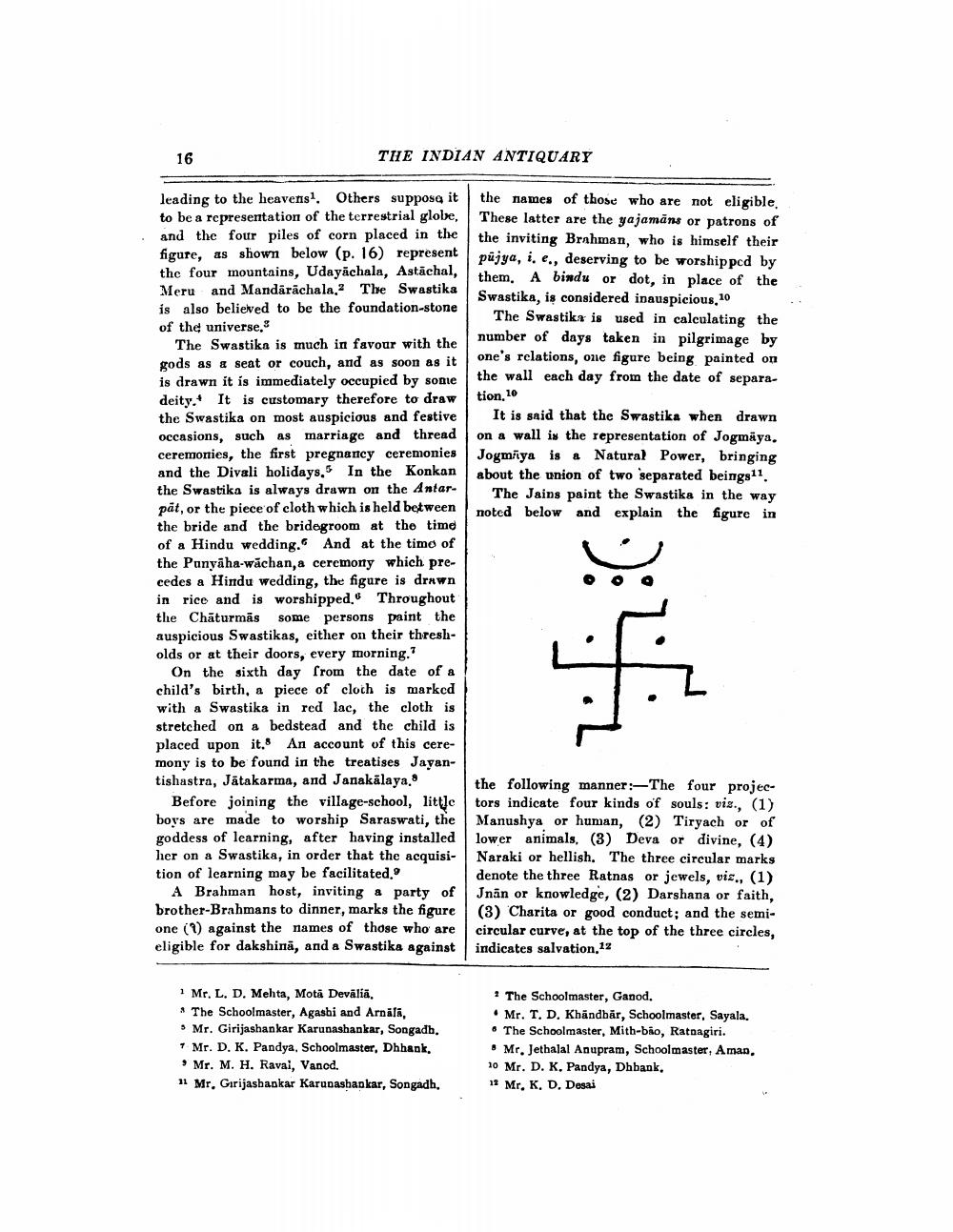________________
16
THE INDIAN ANTIQUARY
leading to the heavens. Others suppose it the names of those who are not eligible. to be a representation of the terrestrial globe, These latter are the yajamāns or patrons of and the four piles of corn placed in the the inviting Brahman, who is himself their figure, as shown below (p. 16) represent
pujya, i, e., deserving to be worshipped by the four mountains, Udayachala, Astáchal,
them. A bindu or dot, in place of the Meru and Mandarāchala. The Swastika
Swastika, is considered inauspicious, 10 is also believed to be the foundation-stone
The Swastika is used in calculating the of the universe, The Swastika is much in favour with the
number of days taken in pilgrimage by gods as & seat or couch, and as soon as it
one's relations, one figure being painted on is drawn it is immediately occupied by some
the wall each day from the date of separadeity. It is customary therefore to draw tion. 10 the Swastika on most auspicious and festive It is said that the Swastika when drawn occasions, such as marriage and thread on a wall is the representation of Jogmaya. ceremonies, the first pregnancy ceremonies Jogmiya is & Natural Power, bringing and the Divali holidays,5 In the Konkan about the union of two separated beings'l. the Swastika is always drawn on the Antar
The Jains paint the Swastika in the way påt, or the piece of cloth which is held between
noted below and explain the figure in the bride and the bridegroom at the time of a Hindu wedding. And at the time of the Punyaha-wachan,a ceremony which precedes a Hindu wedding, the figure is drawn in rice and is worshipped. Throughout the Chaturmās some persons paint the auspicious Swastikas, either on their thresholds or at their doors, every morning."
On the sixth day from the date of a child's birth, a piece of cloch is marked with a Swastika in red lac, the cloth is stretched on a bedstead and the child is placed upon it. An account of this ceremony is to be found in the treatises Jayantishastra, Jätakarma, and Janakālaya.
the following manner-The four projecBefore joining the village-school, little tors indicate four kinds of souls: viz., (1) boys are made to worship Saraswati, the Manushya or human, (2) Tiryach or of goddess of learning, after having installed lower animals. (3) Deva or divine, (4) her on a Swastika, in order that the acquisi- Naraki or hellish. The three circular marks tion of learning may be facilitated."
denote the three Ratnas or jewels, vis.. (1) A Brahman host, inviting a party of Jnan or knowledge, (2) Darshana or faith, brother-Brahmans to dinner, marks the figure (3) Charita or good conduct; and the semione (1) against the names of those who are circular curve, at the top of the three circles, eligible for dakshina, and a Swastika against indicates salvation 12
1 Mr. L. D. Mehta, Mota Deväliä. * The Schoolmaster, Agashi and Arnali, • Mr. Girijashankar Karunashankar, Songadh. + Mr. D. K. Pandya, Schoolmaster, Dhhank,
Mr. M. H. Raval, Vanod. 11 Mr. Girijasbankar Karunashankar, Songadh.
• The Schoolmaster, Ganod. • Mr. T. D. Khandhår, Schoolmaster, Sayala. * The Schoolmaster, Mith-bio, Ratnagiri. • Mr. Jethalal Anupram, Schoolmaster. A man. 10 Mr. D. K. Pandya, Dhbank, * Mr. K. D. Desai




